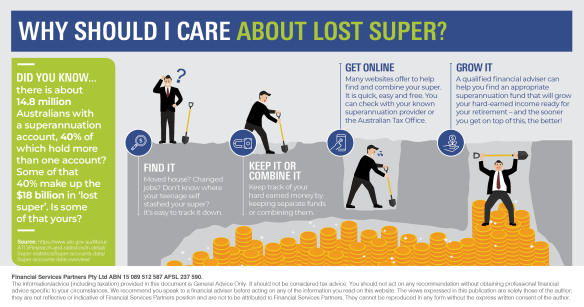
by Jodie | Jun 12, 2018 | Money, Superannuation
Lost Super stats
Did you know there is about 14.8 million Australians with a superannuation account? Around 40% hold more than one superannuation account? Some of that 40% makes up the $18 billion in ‘lost super’. Is some of that yours? Should you care about lost super?
Find it
Have you moved house since starting work? Changed jobs over the years? Don’t know or remember where your teenage self stashed your super? It’s easy to track it down. It’s time to care about your lost super.
Combine it
Combining your multiple accounts can help save on fees and reduce your paperwork. Having all your superannuation together in a single account means you can keep track of your hard earned money. Even further grow your retirement fund.
Get online
Many websites offer to help find and combine your super. It is quick, easy and free. You can check with your known superannuation provider or the Australian Tax Office.
Grow it
A qualified financial adviser can help you find an appropriate superannuation fund that will grow your hard-earned income ready for your retirement – and the sooner you get on top of this, the better! Give the team at Wealth Planning Partners a call if you’d like to grow your super.
Source: https://www.ato.gov.au/About-ATO/Research-and-statistics/In-detail/Super-statistics/Super-accounts-data/Super-accounts-data-overview/

by Amanda Cassar | Jun 5, 2018 | Finances
“Cancer isn’t always a matter of genetics or bad luck.” – Prof. David Whiteman, Brisbane’s QIMR Berghofer Medical Research Institute.1
A recent study from the institute found risky habits and behaviour are to blame for more than 16,000 Australians being diagnosed with cancer each year.2 The good news is that changing these behaviours may help prevent certain cancers forming.
The most common types of cancers that are directly related to lifestyle choices include skin melanomas; lung, bowel, liver and stomach cancers.3
The key culprits causing these types of cancers are pretty obvious to most of us, and include:
- smoking
- high intake of red & processed meats
- low fruits and vegetables
- excessive exposure to UV light
- excessive alcohol consumption
- physical inactivity
- overweight.4
You don’t need to be a genius to know it all boils down to what we put in our bodies and how often we move.
So, what changes can you make for a healthier lifestyle?
- The biggest cause of preventable cancer is smoking, so your first mission is to “hang tough, don’t puff!”5
- Eat more fruit and veg and reduce red and processed meat –going vegetarian just two days per week may help you create a more balanced diet. You might even be surprised at some of the tasty and creative options available minus the meat!
- Decrease the grog – limit drinks to special occasions, weekends or set yourself the challenging of nursing one to two drinks only at a party.
- Exercise regularly – exercise helps reduce risks of various physical and mental health problems.6 If you have a sedentary ‘sit on youb bum’ lifestyle, even committing to 15 minutes of walking a day could be a great start.
- Reduce exposure to UV light – get your rays early in the morning or late in the afternoon and use a combination of protective clothing, shade and sunscreen. The tan bed has got to go!
1-5 ABC News, (2017), ‘Changes to risk factors could have prevented 40 per cent of cancer deaths, study finds’. Available at: http://www.abc.net.au/news/2017-12-12/cancer-study-finds-40pc-deaths-preventable-with-lifestyle-change/9247876
6 Australian Government, Department of Health, ‘Physical Activity’. Available at: http://www.health.gov.au/internet/main/publishing.nsf/content/phy-activity
by Jodie | Jun 4, 2018 | Advisers, Budget, Finances, Money, Retirement, Savings, Superannuation, Taxation
The end of financial year doesn’t have to be too taxing a time. These five tips will help organise your finances for the coming financial year.
Take the pain out of EOFY by being organised. With the right preparation, you can make lodging your tax return a painless process and maybe even increase your refund!
Firstly…
1. Plan ahead
Decide when and how you will lodge your tax return. Will you do it online, via a lodgement service, the MyGov portal or ask your accountant? Your choice may depend on the complexity of your affairs but whichever option you choose, allocate time in advance. Often, it can be a great idea to meet with your adviser or accountant in June to ensure you are maximising the deductions and investments available before June 30. Don’t leave it to the last minute and find out you’ve missed out!
2. Find all you need
Often the most challenging part of lodging your tax return is finding all the relevant paperwork if you haven’t been of top of it all year. It can pay to keep your tax information together through the year, including receipts and bank and credit card statements. You’ll also need payment summaries, records of interest, details of any foreign pensions, your spouse’s income details and other records if you have investments or rental properties. You can see the complete list on the ATO website. If you’re not great at being overly organised, invest in a tray or spike that you can put all the relevant paperwork on as it comes in so that it’s handy when you need it each year.
3. Know your deductions
Many people don’t realise what you can claim tax deductions on. From dry-cleaning to charitable donations and superannuation contributions, knowing what expenses are tax-deductible may increase your tax refund significantly. Typical deductions include work-related training or courses, uniform costs, some insurances and office expenses.
The ATO website has a useful list of deductible expenses. If you want to get ahead, you could even purchase deductible items for next year before June 30 so they’re deductible against this year’s income. Again, it’s worth checking in with your accountant early to ensure you get it right.
4. Boost your super – and your spouse’s
By sacrificing some of your pre-tax salary throughout the financial year, you can increase your retirement savings but also reduce your taxable income. Salary sacrifice contributions are taxed at a maximum rate of 15%[1] which may be less than your marginal rate. Popping in a lump sum prior to June 30 also works for many – just make sure you get the type of contribution right!
Also, contributing to your spouse’s super will boost their super savings and you may be entitled to a tax offset if your spouse earns less than $13,800.
5. Get ready for the year ahead
The end of the financial year is a great opportunity to understand your finances. Usually, you have until October 31 to finalise a personal return. After lodging your return you should be well equipped to plan for the next financial year. Start thinking about how you can improve your budget or if you have the funds to invest.
Automating a small savings program can have small funds quickly add up.
By following these tips, speaking with a financial adviser or accountant and conducting your own research too, you should be ready to transition easily into the new financial year.
[1] Australian Taxation Office. Accessed at www.ato.gov.au/Individuals/Super/Growing-your-super/Adding-to-my-super/Salary-sacrificing-super/


